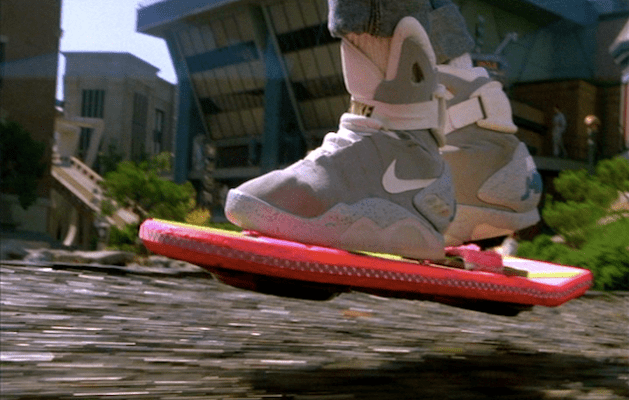Editor’s Note: Moshe Hogeg is the founder, managing partner and chairman of the Israeli investment fund Singulariteam, and the chief executive and founder of Mobli and Yo.
It’s hard to believe that we’ve actually made it ‘back to the future’.
In the 25 years since the second film in the Back to the Future trilogy came out, much of the director’s vision of the future has been borne out. And that fact holds some interesting lessons for entrepreneurs.
Rather than try to invent something entirely new, they chose to use innovations on existing products.
Entrepreneurs should approach building new businesses in the same way. There’s no need to invent new industries, because there’s just as much opportunity in taking the proverbial skateboard and turning it into a hoverboard (which we’re still waiting for).
Looking at today’s tech giants, it’s easy to spot companies that have leveraged an existing target audience using innovative technologies. The lodging industry has been around since the dawn of man, and yet, AirBnB managed to find a new way to approach it by using tech, benefiting both consumers and those who wish to turn space in their homes into available income.
As entrepreneurs look for the next opportunity, some obvious industries have emerged that are ready for a technological revolution, including the news business, entertainment, home delivery, and transportation.

The News Industry
We’ve all heard the old saying ‘No News is Good News,’ but the truth is that few of us feel we can survive without our daily download of information. While the way we consume our news has become less reliant on print and more on the web, the basic principle of news hasn’t changed much: Information is processed by a writer or reporter and served to us on the other end.
It’s evident that this is starting to change. Since the shift to online news consumption began to take hold, users have gained much more control of the information and many choose what to read from numerous different sources. And yet, this is not a ‘disruption’ of the news industry, but rather, an ‘adaptation’.
The true disruption of the news business will manifest in the creation of content that’s contextually relevant, democratically produced, and personalized through a network of trusted sources.
Context is King
If you know ‘when’ and ‘where’ to say something, you can narrow down the ‘what.’
Last year, I launched Yo, the single syllable app. While people thought it was just a joke, no matter how many people started using it and how popular it became, the application of contextually relevant information changed people’s minds. New use cases, including news, began to be created around Yo.
When you get a ‘Yo’ from USA Today, you instantly know it’s about the news, and not about last night’s NBA scores, before you ever click the link.
Eliminating The Middleman
Not too long ago, you needed an expensive and fancy video camera to record live events as they happened. Now, with virtually everyone having a camera and internet access on their phone, immediate and live reporting is now available to the masses at their fingertips. Since broadband streaming over 3G, 4G and LTE is a relatively recent phenomenon, it is only now that these apps are starting to emerge.
Ephemeral messaging was all the buzz in 2014, and that has a lot to do with it. In fact, many of these apps now enable group chats, and Snapchat has already launched channels, attracting millions of users.
Crowdsourced Personalization
Recommended content is used by major outlets, who no longer shy away from directing their readers to other websites – especially when it proves to be such an efficient way to monetize. But it won’t stop there. Content will become more personalized and 3rd-party applications will present each user with a unique newsfeed that is based on preferred content – not preferred outlets. This is something that has already begun, but is really starting to take off now.
The Delivery Industry
Much like the news industry, the delivery industry hasn’t changed much in centuries. True, we no longer need runners to deliver messages from the Battle of Marathon, but packages are still delivered the same old way they have been — transported on a vehicle and carried by a human. However, that may very well change drastically over the next decade.
At the beginning of the 20th century, a plane passing overhead was one of the rarest things you could see. Now, most people see them on a daily basis. Pretty soon, the same will be true for drones, floating around with your package from Amazon.
The underbelly of this industry has advanced and changed beyond recognition. There are videos showing a delivery sorting warehouse where robots outnumber humans 10 to one. And the drones are not far behind: Just recently, Amazon threatened to move its drone testing outside of the US, frustrated by the strict government regulations – another testament that flying pizza-delivery robots will soon be commonplace and cease to exist only in the realm of science fiction.
I have an interest in this industry thanks to my involvement in General Robotics, but the development in this space is remarkable. Numerous startups including Bringg and Delivery Hero aren’t waiting for a future with flying drones, and are instead rolling out powerful solutions right now.
The Movie Industry
More than twenty years ago, it was said that DVD’s would be the death of movie theaters. However, as movie streaming becomes more popular and DVD rentals have all but disappeared – movie theaters are still standing strong.
Not everyone can afford a giant TV and there is something to be said for the century-old experience of complete immersion that is a movie theater. Yet, right around the corner, two new versions of reality present a real threat: AR and VR.
Virtual Reality is nothing new, we all remember those weird arcades from the 90’s with the Tron-like helmets and handheld controllers. Yet, that kind of VR didn’t really cut it. Two decades later, we have the computing power and the manufacturing capabilities to make a home VR experience not only possible, but affordable.
While popular applications are in the realm of games, we are not far from the day in which the viewer could ‘walk’ through a movie scene as it happens for a whole new level of immersive experience. Very recently, it was announced that YouTube will be supporting 360 degree videos for a completely immersive experience.
Why should we go to a local theater if we can enjoy the same experience while sitting at home or even riding the bus to work or school? Augmented Reality will make it possible to replicate a movie-going experience anywhere, by projecting an image on glass lenses.
Singulariteam has invested in both InfinityAR, which is working on a software solution to enable AR experiences, and Meta, which is building AR glasses. With Microsoft’s recent Hololens announcement, it’s clear that the time for more advanced AR solutions is coming sooner than most had predicted. Of course, AR is already here, if not in it’s completely immersive form. Apps like Selfit, which let’s users augment their selfies show that people are eager to mix up their reality with something a bit more fun and playful.

The Transportation Industry
The greatest revolution in the realm of computing didn’t come from improvements in hardware, but rather, when we were able to develop software and enable computers to communicate with each other through the internet. And that machine-to-machine communication is how the transportation and automotive industry will get disrupted.
There are already apps out, including Google maps, Waze and Moovit, that are constantly monitoring traffic and public transportation. It’s only a matter of time before cars start using that information and ‘talk’ to each other. And the self-driving car is getting closer to becoming commonplace, while Mobileye keeps driving higher.
The Israel-based company is in the pole position when it comes to camera-based Advanced Driver Assistance Systems. At the same time, Mercedes and Audi have just introduced their self-driving cars at CES and Google has already unveiled its autonomous vehicle. AR solutions are also coming to transportation, such as WayRay, which is working to display navigation info on your windshield.
It’s also possible that transportation might go the other way. Instead of complicated, self-driving cars, we might see smaller, simpler, and greener personal urban vehicles. CES saw the release of solutions like Gogoro and INU, which come as a reaction to cities across the globe taking steps to ban cars from their city centers
With each new innovation, we get closer to completely transforming something that we all take for granted. I truly believe that in the not-so-distant future, I might be able ride to the office in a driverless car while reading a personalized news feed, floating on a virtual paper I’m seeing with my AR glasses that were delivered to me by a flying drone. Or maybe, like Marty McFly, I’ll just travel around on an actual hoverboard.


